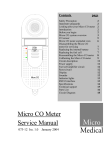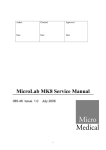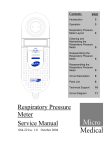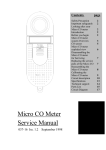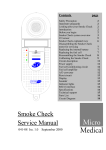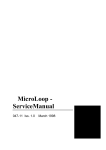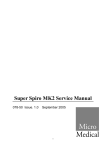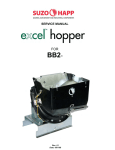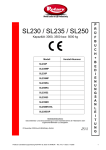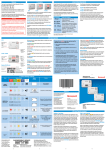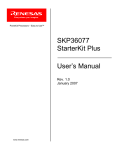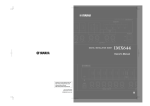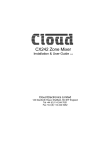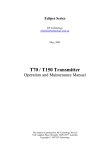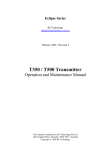Download Baby CO Meter Service Manual
Transcript
Contents Safety Precaution Important safeguards Looking after your Baby CO meter Introduction Before you begin Baby CO system overview CO sensor Baby CO meter exploded view Disassembling the Baby CO meter for servicing Replacing the internal battery Replacing the fuel cell Reassembling the Baby CO meter Calibrating the Baby CO meter Circuit description Power supply Fuel cell amplifier circuit Reset circuit Display Sounder Indicator lights RS232 interface Specifications Technical support Parts List Circuit Diagram FCOHb CO OFF Baby CO Meter Service Manual 113-19 Iss. 1.0 page Jan 2007 2 2 2 2 2 3 5 6 7 7 7 8 9 11 11 12 12 12 12 13 13 14 15 16 18 Baby CO Meter Service Manual Information in this document is subject to change without notice and does not represent a commitment on the part of Micro Medical Limited. Only the parts supplied by Micro Medical Limited should be used to complete the service operation described in this manual. If in any way you feel unsure about the successful completion of the service operation you should contact Micro Medical Limited or its appointed agent in your country or region and arrange the despatch of the product to a Micro Medical Limited Service Centre. Copyright 2005 by Micro Medical Limited All rights reserved Drawing no. 113-19 Version 1.0 September 2007 All other products are trademarks or registered trademarks of their respective owners. 1 Safety Precaution The servicing of this device is intended to be carried out by a properly trained and competent electronics engineer, or experienced in the maintenance and servicing of medical devices. Read this manual thoroughly before proceeding with the service. If in any doubt please contact the service centre at Micro Medical Limited or their accredited agent in your country or region. Important Safeguards ο Read all of the instructions. ο Keep the instructions in a safe place for later use. ο Follow all warnings and instructions marked on the product. ο When replacement parts are required, be sure to use replacement parts specified by Micro Medical that have the same characteristics as the original parts. Unauthorised substitutions may result in fire, electric or other hazards. ο Do not place on an unstable table. ο The product should be operated only from the type of power source indicated on the label. Looking after your Baby CO Meter ο Avoid exposing the Baby CO Meter to solvents including alcohol and disinfectants. ο Avoid operating the Baby CO Meter in dusty conditions or near to heating appliances or radiators. ο Do not keep the Baby CO Meter in a damp place or expose it to extreme temperatures. Introduction This service manual provides you with information to carry out the servicing of the Baby CO Meter. It is a process, which is relatively straightforward but must be carried out in a logical sequence. Our advice is to familiarise yourself with the contents of this manual before attempting to carry out the procedure of replacing the parts supplied in the sensor replacement kit for the Baby CO Meter. Before You Begin Before you begin the servicing operation, please read the section on Circuit description very carefully: 2 Baby CO Meter system overview. The Micro Medical Baby CO meter consists of a hand held microcomputer unit (1) incorporating a CO sensor and is supplied with a mouthpiece adapter with integral one way valve (2) together with disposable cardboard mouthpieces (5). The microcomputer unit is powered by a single alkaline PP3 battery (4) and is supplied with a reducing connector for calibration (3). 1 2 3 FCOHb CO OFF 4 5 6 3 The CO sensor is an electrochemical fuel cell, and works through the reaction of carbon monoxide at one electrode and oxygen (from ambient air) at the other. This reaction generates an electrical current proportional to the concentration of CO exposed to the sensing surface of the fuel cell. The current output signal from the sensor is conditioned using a current to voltage converter and is applied to an analogue to digital (A/D) converter. When the unit is first switched on the microprocessor records the baseline reading on the A/D input and uses this value to auto zero the instrument. The subject is requested to breathe in maximally, hold the breath for 10 seconds, and then to expire fully through the mouthpiece connected to the microcomputer unit with the mouthpiece adapter. As an aid to timing the breath holding period a countdown from 10 to 0 is displayed after the unit is turned on. The microprocessor then records the peak value obtained and displays this on a 3½ digit LCD display. The value can be displayed either as parts per million (ppm) concentration in the expired air or as the equivalent percentage carboxyhaemoglobin (%COHb) using the mathematical relationships described by Jarvis et al, for concentrations below 90ppm and by Stewart et al for higher concentrations. Jarvis MJ, Belcher M, Vesey C, Hutchison DCS Low cost carbon monoxide monitors in smoking assessment. Thorax 1986; 41:886-887 Stewart RD, Stewart RS, Stamm W, Seleen RP Rapid estimation of carboxyhaemoglobin levels in fire fighters JAMA 1976; 235:390-392 As a quick guide to the estimated smoking level, red, amber and green indicator lights are provided. The following levels of CO activate these lights: CO(ppm) %COHb Cigarette consumption Indicator 0-5 0 - 0.8 Non smoker Green 6 - 10 1 - 1.6 Light smoker Amber 11 - 72 1.8 - 12 Heavy smoker Red >72 >12 Suspected poisoning Red + alarm 4 CO Sensor The sensor is an electrochemical micro fuel cell using gaseous diffusion barrier technology resulting in a direct response to volume concentration rather than partial pressure. The cell consists of a working electrode and a counter electrode separated by a thin layer of electrolyte. The gaseous diffusion barrier limits the flow of gas to the sensing electrode and ensures the electrochemical activity of the electrode is far in excess of the amount of gas with which it has to deal. Gas diffusing onto the working electrode reacts at the surface of the electrode by oxidation. CO reacts at the working electrode according to the equation: CO + H2O → CO2 + 2H+ + 2eThe counter electrode acts to balance out the reaction at the sensing electrode by reducing oxygen in air to water: ½O2 + 2H+ + 2e- → 2 H2O 5 Baby CO meter exploded view Item 6 Item 5 Item 4 Item 3 Item 9 Item 10 Item 7 Item 8 6 Item 2 Item 1 Disassembling the Baby CO meter for servicing. The Baby CO microcontroller unit comprises of a solid state electronic circuit in a robust ABS housing and does not require any preventative maintenance. Routine maintenance consists of replacing the fuel cell and internal lithium battery when they are exhausted. The 3.6 volt lithium battery is continuously monitored by the microcontroller and the message bt2 will be displayed when the voltage falls below 3 volts. The fuel cell exhibits a gradual loss of sensitivity with time and has effectively expired when the unit can no longer be calibrated. When either the fuel cell or the lithium battery has expired, replace by following the procedure below. 1. Turn the unit face down and slide back the battery compartment. 2. Remove the PP3 battery. 3. Remove the 2 self tapping screws (Item 1) and put to one side. 4. Lift the top moulding (Item 6) from the bottom moulding (Item 2). 5. Remove the PCB (Item 3) from the bottom moulding. 6. If the fuel cell (Item 4) is exhausted carefully remove by gently pulling away from the PCB. 7. If the battery (Item 8) has expired, then note the orientation and remove from the PCB-mounted clips by pulling on the battery strap (Item 7) directly away from the PCB. Put the battery strap to one side and discard the battery. Replacing internal battery of the Baby CO. 1 Place the battery strap over the new battery (Cat No: BAT5900) and push into the PCB-mounted clips ensuring the correct orientation. (Take great care not to short circuit the terminations even momentarily as the low internal impedance of lithium batteries will result in a high current consumption and greatly reduced life). Replacing fuel cell of the Baby CO. 1 Remove the CO sensor (Cat No: CEL7300) from the plastic container. 2 Carefully insert the CO cell into the PCB with the correct orientation. 7 Reassembling the Baby CO meter 1. Place the PCB into the bottom moulding. 2. Tuck the battery strap between the battery and the side wall of the bottom moulding, away from the slide switch. 3. Ensure that the slide switch (Item 9) and the switch plate on the top moulding (item10) are both positioned at the bottom of their travel. 4. Ensure that the rubber gasket (Item 5) is in place in the top moulding. 5. Place the top moulding on top of the bottom moulding ensuring the rubber gasket fits over the cell correctly and secure using the two self-tapping screws. 6. Reconnect the PP3 battery ensuring correct polarity. 8 Calibrating the CO meter Calibration will remain stable to within 2% over one month and typically to within 10% over 6 months. Micro Medical supplies calibration gas (20ppm CO in air) and recommends that the unit is recalibrated on a 6 monthly basis. See page 13 for calibration accessories. To carry out the calibration locate the calibration switch on the right hand side of the instrument as shown below. Serial port Calibration Switch Push the slide switch to the CO - PPM position and wait for the unit to display zero. 9 Screw the control valve firmly onto the cylinder and connect the gas supply as shown below: Plastic Tubing Control valve Flow indicator Reducing Connector for calibration 20 ppm carbon monoxide in air The plastic tubing supplied with the gas should be pushed firmly over the reducing connector. Slowly turn the control knob anti-clockwise until the ball in the flow indicator is between the two marks. This will then supply a gas flow of approximately 0.25 l/min. Apply this flow for 25 seconds and if the meter does not read 20ppm use the calibration tool to push the calibration switch. The unit will then beep 3 times, store the new calibration value, and display the following: The gas supply should then be turned off. 10 Circuit description (Refer to the parts list and circuit diagram) The circuit is based on the Hitachi one time programmable (OTP) microcontroller HD64F3687FP (U5) operating at a clock frequency of 14.745MHz. This processor contains EPROM, RAM, and eight 10-bit analogue to digital (A/D) converters. The current output signal from the sensor is conditioned using a current to voltage converter and is applied to an A/D input of the microcontroller. Voltages derived from the external PP3 battery and the internal lithium battery are also connected to the A/D converter inputs. When the unit is first switched on the microprocessor records the baseline reading from the A/D and uses this value to auto-zero the instrument. The signal from the CO sensor is continuously monitored and the peak of the calculated carbon monoxide concentration is displayed and transmitted through the RS232 driver (U7). Power Supply The unit has two separate supplies. The externally accessible alkaline 9 volt PP3 battery (BAT 1) provides the main supply. The instrument may be switched on and off with the slide switch and may also be switched off by a signal from the processor. This is done if the unit is left on, without use, for a period of 4 minutes in order to conserve battery power. The supply is controlled by gates U2 and U3 arranged in a bi-stable configuration, and powered continuously from BAT1. When the slide switch is moved to the ‘CO-PPM’ position one end of R7 is pulled low. This transition is differentiated by the action of C15 and R6 so that a momentary pulse appears on pin 2 of U3. This pulse will toggle the bi-stable circuit so that pin 4 of U2 will go low, turning transistor TR2 on, and supplying 9 volts to the low drop-out regulator, U4. When the slide switch is returned to the ‘off’ position pin 1 of U2 is pulled low, the bi-stable action is reversed, and TR2 will be turned off. If the unit is left on without use for approximately 4 minutes then pin 44 of U5 is driven high, under software control, turning on TR1 which will also turn the unit off via the bi-stable circuit. When this happens the slide switch must be pushed to the ‘off’ position and then to the ‘CO-PPM’ position in order to initiate another pulse through C15 to turn the unit back on again. The output of the 5 volt regulator supplies the processor and associated circuitry. C13 and C14 smooth the input and output of U4. BAT1 is monitored by an A/D input of the microcontroller, pin 62 through the potential divider, R13 and R14. When this battery falls below 6.6 volts a battery low warning is temporarily indicated on the display upon switch on. When the battery falls below 6.1 volts the message is displayed permanently and the unit cannot be used. 11 The secondary power supply is provided by a single 3.6 volt lithium cell, BAT2, used to permanently power the fuel cell amplifier circuit consisting of the op-amp U1 and associated passive circuitry. The amplifier circuit draws less than 11uA from the 1000mA-Hr lithium battery giving a nominal operational life of greater than 10 years. BAT2 is buffered by U8B and monitored by an A/D input of the microcontroller, pin 63. R27, between BAT2 and the inverting amplifier, prevents the battery from discharging through the op-amp when the supply is switched off. The battery has an end point of 3 volts and when this level is reached the message bt2 will be displayed. When this happens follow the procedure outlined in Servicing. Fuel cell amplifier circuit. The fuel cell provides an output current, from the counter electrode, proportional to the concentration of target gas at the sensing surface. This current is converted to a voltage by the action of U1 and the associated passive components at a nominal transfer factor of 387mV/µA. This signal is further amplified by U8A with a gain of 2.08 and applied the A/D input of the microcontroller, pin 44, after being filtered by the action of R8 and C4. The sensitivity of the CO fuel cell is 0.045 +/- 0.015µA giving a nominal amplified output of 36mV/ppm CO. Reset Circuit This microcontroller has internal reset circuitry that requires C12 and D5 for proper operation. Display The display is a custom 3½ digit low power LCD. The segments and backplane are driven directly by microcontroller. The backplane is driven by a square wave of nominally 60Hz. The individual segments are driven by a similar square wave that is in phase with the backplane when the segment is off and 180 degrees out of phase when the segment is on. Sounder The sounder is operated by a 1kHz square wave generated by pins 24 and 25 of U5. 12 Indicator lights The three indicator LED’s are driven from pins 51, 52 and 53 of the microcontroller through transistors TR3, TR4 and TR5. RS232 interface The transmit and receive ports for RS232 transmission are on pins 46 and 45 respectively of the microcontroller. The transmission is converted from logic to RS232 levels by the U7. 13 Specifications Type Electro - chemical fuel cell Range 0 - 100ppm Resolution 1ppm Green indicator light 0 to 6ppm (0 to 1% COHb) Amber indicator light 7 to 10ppm (1.1 to 1.6% COHb) Red indicator light 11 to 72ppm (1.8 to 12% COHb) Flashing red light + alarm >72ppm (>12% COHb) Accuracy +/-5% of full scale of 1ppm whichever is the greater Sensitivity drift 0.5%/°C Sensor Life >2 to 5 years Response time <15 sec (to 90% of reading) Hydrogen cross sensitivity <15% Operating temperature 15 to 25°C Operating pressure Atmospheric +/-10% Pressure coefficient 0.02% signal per mBar Relative humidity 15 – 90% continuous (Non condensing) (0 – 99% intermittent) Baseline drift 0ppm (auto zero) Long term drift <2% signal loss per month Power source Single Alkaline 9 volt PP3 Main battery life >30 hours of continuous use Internal battery life 10 years Weight 180g (Including battery) Dimensions 170 x 60 x 26mm Display 3½ digit LCD Storage temperature -20 to +70 deg Celsius Storage humidity 30% to 90% 14 Technical Support Great Britain and World Headquarters Micro Medical Ltd PO Box 6 Rochester Kent ME1 2AZ Telephone + 44 (0)1634 893500 Fax +44 (0)1634 893600 Web Site http://www.micromedical.co.uk Email [email protected] Contact Micro Medical Ltd for the local agent in your region or country for local service: 15 Parts List Designation U1 U2 U3 U4 U5 U6 U7 U8 D1 D2 D3 D4 D5 DISPLAY TR1 TR2 TR3 TR4 TR5 R1 R2 R3 R4 R5 R6 R7 R8 R9 R10 R11 R12 R13 R14 R15 R16 R17 R18 R19 R20 R21 R22 R23 R24 R25 R26 R27 C1 C2 C3 C4 Description OP90GS. Precision micro power surface mount BU4S11. Single NAND gate BU4S11. Single NAND gate LM2931M5.0. Low drop-out 5 volt regulator HD64F3687FP. Hitachi microcontroller 24LC00. 16 Byte surface mount serial EEPROM MAX3221CAE. Maxim RS232 transceiver MCP602-I/SN. Microchip dual rail-to-rail OP-AMP ZHCS750 Schottky diode 3mm green LED 3mm red LED 3mm yellow LED BAS21. Small signal diode (LCD 016-03) 3½ Digit custom display DTC114EKA NPN transistor FMMT591 PNP transistor DTC114EKA NPN transistor DTC114EKA NPN transistor DTC114EKA NPN transistor 330K Resistor 12K Resistor 1M Resistor 10K Resistor 10K Resistor 1M Resistor 1M Resistor 100K Resistor 10K Resistor 560R Resistor 560R Resistor 820R Resistor 100K Resistor 100K Resistor 100K Resistor 10K Resistor 1M Resistor 10K Resistor 10K Resistor 10K Resistor 27R Resistor 1K Resistor 10K Resistor 180K Resistor 360K Resistor 390K Resistor 1M Resistor 10µF Tantalum capacitor 22pF Ceramic capacitor 0.1µF Ceramic capacitor 1µF Ceramic capacitor 16 C5 C6 C7 C8 C9 C10 C11 C12 C13 C14 C15 C16 C17 C18 C19 C20 C21 TH1 SW1 SW2 BAT2 X1 CO CELL 22pF Ceramic capacitor 0.1µF Ceramic capacitor 0.1µF Ceramic capacitor 0.1µF Ceramic capacitor 0.1µF Ceramic capacitor 1µF Ceramic capacitor 0.1µF Ceramic capacitor 10nF Ceramic capacitor 0.1µF Ceramic capacitor 47µF Electrolytic capacitor 0.1µF Ceramic capacitor 33pF Ceramic capacitor 33pF Ceramic capacitor 1µF Ceramic capacitor 1µF Ceramic capacitor 0.1µF Ceramic capacitor 0.1µF Ceramic capacitor NTC 47K thermistor SLF2300. Double pole 3 position slide switch Push switch SL235 CVHZ Sonnenschein 1A-Hr ½ AA Lithium cell 14.745 MHz crystal 1000 ppm CO fuel cell 17 A B C 1 C10 1uF R21 27R 5V BAT1 PP3 2 3 1 2 C9 0.1uF C7 0.1uF C6 0.1uF 1 VIN 1 2 3 4 5 6 7 8 2 VOUT U4 LM2931M-5.0 R16 10K JP1 0.1uF C13 8 10K R4 C8 0.1uF 5V 100K R14 100K R13 FMMT591 TR2 1 ZHCS750 3 2 2 J1 JACK MAX3221CAE EN FOFF C1+ 5V V+ C1 TO C2+ FON C2 - TIN VINV RIN RO U7 CALIB_SWITCH SW2 16 15 14 13 12 11 10 9 SPK1 + 5V + 2 1 2 1 1uF C18 2 1 C1 10uF U2 5V 1 2 BU4S11 U3 BU4S11 5V MODE R5 10K 1 C14 47uF 4 4 5 3 5 3 C5 0.1uF C3 10nF C12 22pF C2 22pF R7 1M 18 1 3 ppm D5 10K R23 24LC00 SCL SDA U6 3 3 Vss Vcc 2 5 5V P37 P36 P35 P34 P33 P32 P31 P30 P67/FTIOD1 P66FTIOC1 P65/FTIOB1 P64/FTIOA1 P63/FTIOD0 P62/FTIOC0 P61/FTIOB0 P24 P76/TMOV P75/TMCIV P74/TMRIV P72/TXD_2 P71/RXD_2 P70SCK3_2 P55/WKP5 P54//WKP4 P53//WKP3 P52//WKP2 P51//WKP1 P50//WKP0 P23 P85 P86 P87 SW1A SLF2300 U5 H83687 1 OSC1 OSC2 RST TEST X2 X1 VCC GND VCL AVCC P17/IRQ3 P16/IRQ2 P15/IRQ1 P14/IRQ0 P12 P11/PWM NMI P22/TxD P21/RxD P10 P20/SCK3 PB0/AN0 PB1/AN1 PB2/AN2 PB3/AN3 PB4/AN4 PB5/AN5 PB6/AN6 PB7/AN7 P57/SCL P56/SDA P60/FTIOA0 BAS21 1 3 11 10 7 8 4 5V 5 12 9 6 3 54 LED3 53 LED2 52 LED1 51 25 24 35 46 45 percent 23 44 62 61 60 59 BATT2 63 64 1 2 27 26 36 RST 14.745 X1 0.1uF R6 1M C15 R17 1M for MCU C19 1uF 3 1 10K R9 18 17 16 15 55 56 57 58 40 39 38 37 32 33 34 31 30 29 28 50 49 48 22 21 20 19 14 13 47 41 42 43 P85 P86 P87 SW1B SWITCH_SLF2300 CELL A3 F3 COHb G3 B2 A2 F2 G2 B1 C1 D1 E1 DP2 E2 D2 C2 C3 D3 E3 G1 F1 A1 DP1 CO FOETAL B3 BLOW F BP DTC114EKA TR1 EcoSure-LXH 5 5V 2 4 D1 2 1 2 3 3 6 7 1 3 2 1 W 2 4 percent 20 19 18 17 16 15 14 13 12 11 10 9 8 7 6 5 4 3 2 1 R22 1K 4 C17 33pF ppm 2 3 R20 10K R19 10K R18 10K 5V DISPLAY_FOETAL % ppm B1 C1 A1 COHb F1 F G1 D1 C2 E1 B2 DP1 A2 CO F2 D2 G2 E2 C3 DP2 B3 BLOW A3 D3 F3 E3 G3 FOETAL NC NC NC NC NC NC NC NC NC BP DIS1 75K 0R C21 0.1uF R1 R2 0.1uF C11 - 21 22 23 24 25 26 27 28 29 30 31 32 33 34 35 36 37 38 39 40 OP90 + U1 10K not used R3 TH1 3.6V 7 4 1 5 8 D 1 7 6 R15 100K 5 1 Date: File: B Size R27 3 TR5 C4 1uF + - 1 LED2 7 LED3 1 D3 AMBER R11 560R 5V MCP602 U8B DTC114KE TR4 + - C20 0.1uF DTC114KE TR3 6 Revision 1.0 D4 RED R12 820R 5V 6 9-Jan-2007 Sheet 1 of 1 G:\Development\113 - CO Meter with Foetal %COHb\Hardware\Foetal.ddb Drawn By: D.G.Brown Number 113-01 Foetal CO 5 6 BATT2 MCP602 1 U8A 390K 5V R26 D2 GREEN R10 560R 5V 1M BAT2 BAT3.6V 33pF C16 2 DTC114KE 3.6V Title LED1 R8 100K 360K R25 180K R24 5 1 2 8 4 C 6 8 3 2 3 2 3 2 A B C D



















